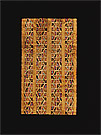Exhibition themes Huari
The Huari (or Wari) people originated in the central highlands, and later spread to the coast and into the north. They adopted many art styles from the Nazca, transforming them as their culture matured. The Huari relationship to the Tiahuanaco culture, which began in Bolivia near Lake Titicaca, is complex. Both empires arose around the sixth century AD and left imposing stone monuments. The Huari borrowed symbols and deities such as the Tiahuanaco Staff God, and then redefined and spread such beliefs as their realm expanded.
Less well known than their Incan successors, the Huari were the first major highland power of the Andes and flourished until the tenth century. The people and culture are named after Huari, the ancient urban capital located 10 kilometres north of the modern city of Ayacucho. Their superb textiles, however, are invariably found preserved in the deserts of the south coast.
The colourful and bold visual language of the Huari can be recognised in abstract tunics, patchwork tie-dyed cloths, large portrait vessels and ceramics for ritual shattering. Architecture entailed the mass hauling of stone to build cities, temples and extensive irrigation infrastructure: aqueducts, terraces and large circular water drains.









